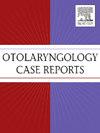Unusual cause of acute tympanic perforation: a case report with brief literature review
IF 0.2
Q4 OTORHINOLARYNGOLOGY
引用次数: 0
Abstract
Introduction
Tympanic membrane perforations (TMPs) are common in otolaryngology and result from infections, trauma, or Eustachian tube dysfunction. Traumatic causes include slap injuries, explosive blasts, barotrauma from activities such as scuba diving or rapid altitude changes, iatrogenic injuries during ear procedures, foreign bodies, skull base fractures, and significant pressure changes during air travel or forceful Valsalva maneuvers. Symptoms often include otorrhea, otalgia, and tinnitus. Most TMPs heal spontaneously with supportive care.
Case presentation
A 28-year-old trumpet player with intermittent allergic rhinitis experienced sudden right ear pain and hearing loss after a prolonged rehearsal. Examination revealed a central perforation of the right tympanic membrane and conductive hearing loss. The diagnosis was an acute traumatic tympanic membrane perforation due to barotrauma from forceful trumpet playing, exacerbated by subclinical Eustachian tube dysfunction and allergic rhinitis. Conservative management led to spontaneous healing within six weeks, and a gradual return to playing was advised.
Discussion
Tympanic membrane perforation (TMP) is typically linked to infections, trauma, or barotrauma. This case highlights a novel occupational cause in a 28-year-old trumpet player, where high intraoral pressures generated during forceful playing, exacerbated by subclinical Eustachian tube dysfunction (ETD) and allergic rhinitis, led to TMP. Prolonged rehearsals caused cumulative pressure buildup that exceeded the tensile strength of the tympanic membrane (TM). Conservative management, including water precautions and abstaining from instrument play, resulted in spontaneous healing. Musicians, particularly brass players, should be educated about ETD risks. Preventive strategies, such as allergy management and modified breathing techniques, are essential to mitigate injury risks in wind instrumentalists.
Conclusion
This report underscores occupational barotrauma as a cause of TMP among wind musicians. Clinicians should evaluate ETD and allergies in symptomatic players. Preventive strategies and research on the effects of instrument-generated pressures can inform safer playing techniques.
急性鼓室穿孔的不寻常原因:1例报告并简要文献复习
鼓膜穿孔(TMPs)在耳鼻喉科很常见,是由感染、创伤或耳咽管功能障碍引起的。外伤性原因包括掌掴伤、爆炸、水肺潜水或快速海拔变化等活动造成的气压伤、耳部手术期间的医源性损伤、异物、颅底骨折、航空旅行或强Valsalva演习期间的显著压力变化。症状通常包括耳漏、耳痛和耳鸣。大多数颞叶关节炎在支持性护理下会自发愈合。一名28岁的小号演奏者患有间歇性过敏性鼻炎,在长时间的排练后突然出现右耳疼痛和听力丧失。检查显示右鼓膜中央穿孔和传导性听力丧失。诊断为急性外伤性鼓膜穿孔,由强力小号吹奏气压伤引起,并伴有亚临床咽鼓管功能障碍及变应性鼻炎。保守治疗导致六周内自行愈合,并建议逐渐恢复比赛。鼓膜穿孔(TMP)通常与感染、创伤或气压性创伤有关。本病例强调了一名28岁小号演奏者的一种新的职业原因,他在用力演奏时产生的高口内压力,亚临床咽鼓管功能障碍(ETD)和过敏性鼻炎加剧,导致TMP。长时间的排练导致累积的压力超过了鼓膜(TM)的拉伸强度。保守治疗,包括饮水预防和避免乐器演奏,导致自发愈合。乐手,尤其是铜管乐手,应该接受有关ETD风险的教育。预防策略,如过敏管理和改良呼吸技术,是必不可少的,以减轻伤害风险的管乐器演奏家。结论本报告强调职业性气压创伤是导致管乐手TMP的原因之一。临床医生应评估ETD和过敏症状的球员。预防策略和对乐器产生的压力影响的研究可以为更安全的演奏技术提供信息。
本文章由计算机程序翻译,如有差异,请以英文原文为准。
求助全文
约1分钟内获得全文
求助全文
来源期刊

Otolaryngology Case Reports
Medicine-Otorhinolaryngology
CiteScore
0.50
自引率
0.00%
发文量
99
审稿时长
21 weeks
 求助内容:
求助内容: 应助结果提醒方式:
应助结果提醒方式:


